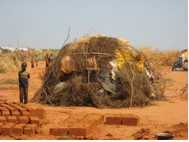Recently, I was able to spend some time with one of the remarkable people I mentioned in my last post. Hassan (not his real name) grew up in the Nuba Mountains region of Sudan. He studied at a university in the capital where government forces arrested him with no charge and held him in prison. After he was released, he got married, started a family and was hired to work for a prestigious international organization which sent him to Nairobi for advanced training. Hassan’s life was as good as he could imagine. While in Nairobi, however, power changed hands in Sudan and educated men like him from his region were being targeted and killed. All of a sudden, a temporary relocation for the purposes of study in a foreign country became a permanent state of refuge. Hassan knew he could not return to his home country of Sudan. He and his family became refugees, traveled to a camp in Kenya and lived with many challenges such as lack of food, water, a harsh climate, and limited employment opportunities to name a few.
Although it is clear that tens of thousands of refugees are living in Nairobi, according to the government of Kenya, refugees are permitted only to live in one of two designated refugee camps unless granted exception. These two camps are Kakuma in the northwest and Dadaab in the northeast. Both of these camps were created in the early 1990?s. Kakuma currently houses about 70,000 East African refugees, while Dadaab is known to be the largest refugee camp in the world with approximately 280,000 refugees. In partnership with the government and international NGOs, UNHCR is managing both of these camps, attempting to provide adequate services and protection for all refugees there. With limited resources however, this is a daunting task and some refugees find that living there is too difficult.
One such person was Hassan, who while living there with his family was attacked and his brother-in-law killed. Putting many people from different nationalities, backgrounds, languages and religions together in a crowded area with scarce resources can often lead to tension. As a minority, Hassan felt this insecurity in Kakuma, therefore, UNHCR provided him protection and permission to live in Nairobi.
As Hassan explains, living in a refugee camp can be difficult. From the Government of Kenya’s perspective, the encampment policy is meant to protect both the refugees and the host population. The government sees camps as providing security, preventing the overburdening of Kenya’s limited resources, and enabling more efficient assistance for refugees. This remains a subject of debate among all concerned for the refugees? welfare.
A boy next to his home in Dadaab refugee camp, Kenya
